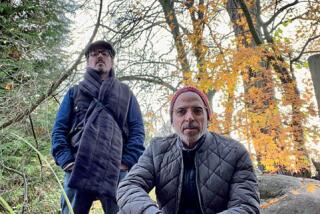Where music and life entwined
- Share via
Lou HARRISON was a domestic man, a hospitable man. In his music, he invites you to share in his delight. And you would be hard-pressed to find music of the second half of the 20th century more warmly beguiling. He was a melodist second to none, his melodies like gifts. They also are like toys, something to play around with.
Music is play; we play it. And Harrison, prolific and eclectic, loved to say, “I spread my toys out on a large acreage.” It was his way of explaining how much fun he had absorbing many distant traditions, be they clavichord dances from Renaissance England or the golden gongs of the Javanese gamelan.
Harrison traveled the world. A trip to Seoul was an instant love affair with Korean court music; he could hardly pull himself away.
But he was in the end a homebody who needed the peace of a rural setting. When he moved to New York in the 1940s, the rush of city life was at first exhilarating but soon overpowering, and he suffered a nervous breakdown. He returned to his parents’ home in Aptos, near Santa Cruz, Calif., and there he stayed. Travel though he did, particularly to Asia, Harrison was always happiest when he could bring Asia home. What he learned in Jakarta, Indonesia, went into the production of Americanized home-built gamelans constructed by his partner, William Colvig.
To visit Harrison at home in Aptos was to enter into a world of domestic activity, of music and life ever entwined. Colvig, inveterate outdoorsman and craftsman, was a whirl of energy, trudging the woods, working on projects. Harrison, plumper, more sedate, was nonetheless a gatherer and sharer as well. A typical visit would include a lesson in sign language (a Harrison passion late in life, following on the heels of an earlier one for Esperanto), a discourse on font design (he was responsible for several), a look at scores and poems in progress, an evening gamelan session. Stories galore and merry laughter.
Harrison was always evolving. “An idea I think our culture got from Europe,” he once said, “is that you have to destroy before you can build something good. Well, I don’t believe that. I’m with the Japanese who say, no, keep the old. Just put the new along with it. ‘Try everything’ is my idea. What’s more, have fun with it.”
This is exactly what Harrison did with the straw bale house. Like his music, it is a hybrid built of unexpected materials. Like his music, it takes, with fancy and fantasy, from East and West. Like his music, it is designed with a craftsman’s sense of exactitude. Like his music, it exults in the warm beauty and hospitality of the world he lived in. Like his music, it, too, is music.
Harrison’s last piece, “Scenes From Nek Chand,” written for steel guitar and the one work he heard played in the straw bale house, was his final romp in his musical playground. On his mind was the Hawaiian guitar music he listened to on the radio as a young boy while his mother played mah-jongg with friends. On his mind, too, was Chand, who built a garden of fantastical sculptures out of recycled garbage in India. Harrison loved such renewal, and he told me, shortly before he died, that he considered Chand the greatest artist of our time. It took one to know one.
More to Read
Sign up for The Wild
We’ll help you find the best places to hike, bike and run, as well as the perfect silent spots for meditation and yoga.
You may occasionally receive promotional content from the Los Angeles Times.






